
The iridescent shark,iridescent shark catfish Ikan Patin or tra catfish is a species of shark catfish native to the rivers of Southeast Asia. Despite its name, it is not a shark. It is found in the Mekong basin as well as the Chao Phraya River, and is heavily cultivated for food there.

Hypostomus plecostomus, also known as the suckermouth catfish or the common pleco, is a tropical freshwater fish belonging to the armored catfish family (Loricariidae), named for the longitudinal rows of armor-like scutes that cover the upper parts of the head and body. Although the name Hypostomus plecostomus is often used to refer to common plecostomus sold in aquarium shops, most are actually members of other genera.

The walking catfish is a species of freshwater airbreathing catfish native to Southeast Asia. It is named for its ability to "walk" and wiggle across dry land, to find food or suitable environments. While it does not truly walk as most bipeds or quadrupeds do, it has the ability to use its pectoral fins to keep it upright as it makes a wiggling motion with snakelike movements to traverse land. This fish normally lives in slow-moving and often stagnant waters in ponds, swamps, streams, and rivers, as well as in flooded rice paddies, or temporary pools that may dry up. When this happens, its "walking" skill allows the fish to move to other aquatic environments. Considerable taxonomic confusion surrounds this species and it has frequently been confused with other close relatives. One main distinction between the walking catfish and the native North American ictalurid catfish with which it sometimes is confused, is that the walking catfish lacks an adipose fin.

Sterba's corydoras is a member of the South American Corydoras genus of freshwater aquarium catfish and one of the most popular species of Corydoras due to its attractive markings. The fish is native to the Guaporé River region between Bolivia and Brazil.

The redtail catfish, Phractocephalus hemioliopterus, is a pimelodid (long-whiskered) catfish. In Venezuela, it is known as cajaro, and in Brazil, it is known as pirarara, stemming from the Tupi language words pirá and arara. It is the only extant species of the genus Phractocephalus. This fish is common in the aquarium trade, although its massive adult size makes it unsuitable for all but the largest aquariums. They feed on fish, crustaceans and fallen fruits. They are not evaluated by IUCN.

Farlowella acus is the type species of the armored catfish genus Farlowella, which are commonly known as the twig catfish or whiptail catfish. The species name means “pointed” or a “needle” or “spine”.

Batasio is a genus of catfish of the family Bagridae. These small fish are found in fast-flowing hillstreams throughout South and mainland Southeast Asia.
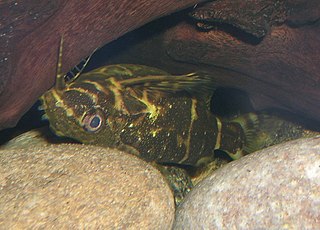
The name upside-down catfish is most commonly used by aquarists to refer to the mochokid catfish Synodontis nigriventris alternately known to ichthyologists as the blotched upside-down catfish or false upside-down catfish. However, a number of other fish may also be known by this name:

Leiarius is a genus of long-whiskered catfishes native to South America. Most of the genus' species are found in the aquarium hobby as ornamental fish.

Mystus is a genus of fish in the family Bagridae native to Asia. Phylogenetic relationships within this genus are poorly understood, though it has been suggested that there are two major lineages.
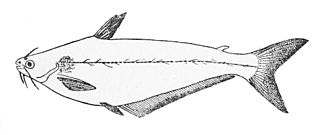
The African butter catfish is a species of fish in the family Schilbeidae. It is native to many major river systems in Africa. Other common names for the fish include butter fish, butter barbel, African glass catfish, lubangu, mystus catfish, silver barbel, and silver catfish. It was originally described as Silurus mystus by Carl Linnaeus in 1758.

Mystus nigriceps, the two-spot catfish, is a species of catfish of the family Bagridae. The species was available in aquarium circles without a scientific name until a connection was made to a description of Mystus micracanthus by the ichthyologist Bleeker, in 1846. The artist's impression at that time showed a catfish without any obvious markings, although another researcher in the early 1940s described it with two body spots. M. micracanthus is a junior synonym of M. nigriceps.

Neoarius berneyi, the highfin catfish, Berney's catfish, Berney's shark catfish, or the lesser salmon catfish, is a freshwater sea catfish that is commonly kept in aquariums. The origin of the name Neoarius berneyi is Greek, with the genus name Neoarius coming from the words neos meaning new and arios, meaning warlike or hostile, in reference to the well developed fin spines, and the species name, berneyi, comes from the ornithologist F. L. Berney.
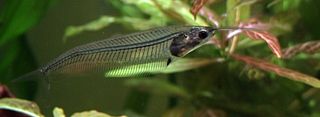
Kryptopterus vitreolus, known in the aquarium trade traditionally as the glass catfish and also as the ghost catfish or phantom catfish, is a small species of Asian glass catfish. It is commonly seen in the freshwater aquarium trade, but its taxonomy is confusing and was only fully resolved in 2013. It is endemic to Thailand, and found in rivers south of the Isthmus of Kra that drain into the Gulf of Thailand and river basins in the Cardamom Mountains. There are also unconfirmed reports from Penang in Malaysia.
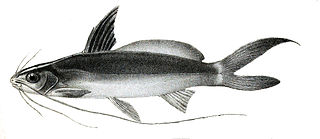
Mystus cavasius, the Gangetic mystus, is a species of catfish of the family Bagridae.
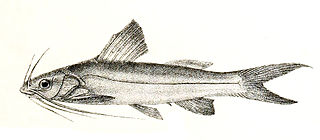
Mystus keletius, is a species of catfish of the family Bagridae. It is native to India and Sri Lanka.

Mystus vittatus, the striped dwarf catfish, is a species of catfish of the family Bagridae. It is found in brackish water systems with marginal vegetation in lakes and swamps with a mud substrate of Asian countries Pakistan, India, Sri Lanka, Nepal, Bangladesh and probably Myanmar. Populations of Southeast Asian countries is in debate, due to close morphological similarities among Mystus species in that region.
Mystus bocourti is a species of catfish endemic to Cambodia, Laos, Thailand and Vietnam, known only from Chao Phraya River and Mekong River. It was formerly listed as Heterobagrus bocourti until the genus Heterobagrus became Mystus. It is demersal and potamodromus and occurs in medium to large rivers. The fish considered rare and declining throughout its range and is threatened by pollution, present and future dams and water extraction for agriculture and human settlements. Considering this and no present conservation measures, the fish is listed as Vulnerable.
Mystus albolineatus is a species of catfish endemic to Cambodia, Thailand and Vietnam, known from Chao Phraya River, Bang Pakong River, Mekong River and Tonlé Sap. It is found in flowing and standing waters especially near submerged woody vegetation; it feeds on zooplankton, fishes and insect larvae such as chironomidae. It spawns before or during the rainy season and the young were first caught in July and August. It occurs in both the market and aquarium trade and is fished with seines, gillnets and traps. It is not considered threatened thus listed Least Concern, however, further research about this fish is needed.
Mystus atrifasciatus is a species of catfish endemic to Cambodia, Laos, Thailand and Vietnam, known from Mekong River, Chao Phraya River and Mae Klong River and was described from Phitsanulok, Thailand. It inhabits rivers, streams and reservoirs and moves to floodplains when the water level increases and can also be found near submerged woody vegetation. It feeds on crustaceans and zooplankton along with some algae and fish scales. It is commonly fished and marketed and is also found in the aquarium trade. It may be threatened by pollution and overfishing and more research is needed about the species.


















